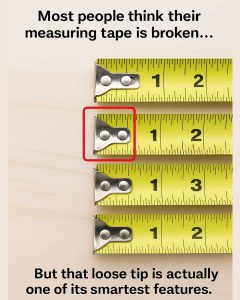In toolboxes across America and beyond, measuring tapes are essential instruments, whether you’re a seasoned professional or a weekend DIY enthusiast. These tools are so common that many users assume they know all there is to know about them. But one particular feature often puzzles or even frustrates users—the loose metal tip at the end of the tape. At first glance, it can look like a defect or something that’s come loose over time. Many people think the tape is broken and try to “fix” it themselves. However, this so-called flaw is actually a smart, purposeful element of the tape’s design. When properly understood, this feature enhances precision and ensures consistent accuracy in a wide variety of measuring situations.

The confusion about the loose tip is widespread. People who notice the slight movement at the end of the tape often think it’s a manufacturing error or a result of wear and tear. Some may even assume their tape is cheap or low-quality. But the truth is that this seemingly unstable hook is intentionally designed to move—just slightly—because it plays a key role in providing accurate readings whether you’re measuring the outside or inside of an object.
The mechanics behind a measuring tape are a subtle blend of engineering and everyday functionality. The tape itself is a flexible strip, usually made from metal, that coils back into a protective case. The numbers and marks printed on the tape are carefully calibrated for accuracy. But it’s the movable hook at the end that often goes unappreciated. This small piece of metal shifts just a fraction of an inch—usually around 1/16 inch (or roughly 1.5 mm)—depending on how you’re using it. That movement compensates for the thickness of the hook itself, ensuring that your measurements are spot-on whether you’re pushing it against an edge or pulling it into a corner.
When you’re measuring the outside of an object, like the length of a tabletop or the width of a beam, the hook pushes inward and the movement subtracts its own thickness from the final measurement. Conversely, when you’re measuring the inside of a space—say the width of a window frame or the inside of a drawer—the hook pulls outward, effectively adding its own thickness to the measurement. In both scenarios, the sliding motion of the hook eliminates the need to mentally adjust for the thickness of the metal tip. It’s a simple yet effective way to make sure the user gets accurate measurements without extra calculations.
This thoughtful design brings several major benefits. First, it guarantees accuracy across different types of measurements. Whether you’re measuring inside or outside, the hook adjusts itself automatically to make sure the reading on the tape is correct. That means you don’t have to mentally subtract or add fractions to account for the hook’s size—it’s all built into the design. This reduces the chance of human error, particularly in high-precision tasks like carpentry or construction. Second, the feature adds to the tape’s versatility. Whether you’re hanging drywall, building furniture, sewing drapes, or measuring for a home improvement project, the same tool performs well across all applications. It’s equally useful for beginners as it is for pros.
Additionally, the sliding hook saves time. Rather than double-checking your math or re-measuring with adjustments, you can trust the tape to be accurate the first time. This is especially helpful when you’re doing repetitive tasks—like measuring dozens of planks or framing multiple windows—where speed and accuracy are both essential. For anyone who’s ever second-guessed their measurements, this feature brings peace of mind. It builds confidence, especially for those less familiar with advanced tools, because it simplifies the process without sacrificing precision.
To get the most out of a measuring tape with a loose tip, it helps to understand how to use it properly. First, know that the movement in the hook is intentional. Test it by sliding it back and forth gently before use so you can feel the range of motion. Next, check that your tape is clean and in good shape. Remove dust or sticky residue that might interfere with the tape retracting smoothly or the hook moving freely. Make sure the surface you’re measuring is flat and stable, as irregularities can impact the tape’s alignment and cause inaccurate readings.
When measuring outside dimensions—like the length of a board—hook the metal tip over the edge of the object. Push the tip in gently, allowing the hook to slide inward and align the zero mark at the exact starting point. Keep the tape straight and taut, and take your reading where the tape enters the housing. For inside dimensions—such as the depth of a cabinet or the width between two walls—place the hook against one surface, pull the tape out so the hook slides outward, and press the tape’s body firmly against the opposite surface. Some tapes have a label showing the length of the case itself (for example, 3 inches or 76 mm), which you should add to your reading for a full measurement.
It’s also important to verify that the hook is positioned correctly for the type of measurement you’re taking. If you’re not sure whether to push or pull the tip, remember this simple rule: push for outside measurements, pull for inside ones. Make sure the tape lies flat and isn’t bent or twisted, which can distort your results. If you’re working on longer spans—more than 6 feet or 2 meters—it might help to have someone hold the hook in place or secure it with a nail or screw temporarily. After use, inspect the hook for any signs of damage, such as bent metal or loose rivets, which can compromise accuracy. Wipe down the tape and store it in a dry place to prevent rust or stiffness.
In conclusion, the loose tip on a measuring tape is not a flaw—it’s a smart, built-in feature that makes your measurements more accurate, your tasks more efficient, and your work more reliable. Once you understand its function, you’ll never look at your measuring tape the same way again. Instead of questioning its design, you’ll come to appreciate the engineering ingenuity that goes into such a simple yet powerful tool. So the next time you pick up a measuring tape, use it with confidence—and know that every inch has been carefully considered for your success.





